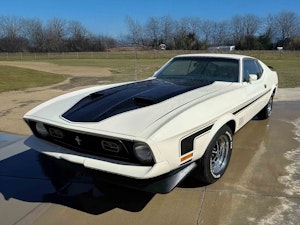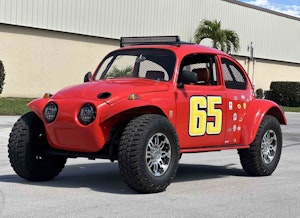Media | Articles
The funky Isuzu VehiCross is a ’90s SUV that deserves more love
The Isuzu VehiCross is a heavily underrated modern-classic. As vanilla crossovers continue to dominate new car sales, drivers looking for more character and comparable practicality are moving towards classic trucks and SUVs. The XJ Cherokee is undoubtedly a classic. Even though Jeep produced millions of them over an 18-year long model run, many low-mile XJ Cherokees sell for over $20,000. You would think an SUV that is rarer and, arguably, possesses more character would be worth more.
That’s not always the case, and the Isuzu VehiCross is a perfect example.
There is a misconception that the VehiCross was a sales failure like the Isuzu Axiom that followed, but the VehiCross was always intended as a limited-production vehicle. Isuzu used ceramic tooling dies instead of steel ones to stamp the oddly shaped body panels, which reduced cost and production time at the expense of tooling longevity. However, this technique allowed Isuzu to start production only a few years after unveiling the VehiCross concept car in 1993. Very few design changes were made from concept to production, much like the 350Z and Audi TT of the era. The ceramic dyes wore out after a total of 5958 VehiCrosses were produced between 1999 and 2001 (4153 were sent to the US and 1805 remained in Japan). Dealers had no trouble keeping them in showrooms, with a base price of $28,900 (or $46,500 in 2020 money). True, scarcity is the key to collectability, but there’s so much more to the VehiCross.
20200319191353)
We need to look at when it was produced to see why the VehiCross is so special. At the turn of the millennium, many manufacturers were overly nostalgic—designing cars that referenced the 1950s like the Chrysler PT Cruiser and new Ford Thunderbird. Ironically, in the 1950s those same manufacturers were designing cars that referenced an optimistic vision of the future with commercial space travel and flying cars. Around 1999, and at a time when most OEMs were caught looking back, Isuzu was looking forward, commemorating the new millennium with a futuristic SUV designed to highlight Isuzu’s ingenuity and off-road technology.
Marketplace
Buy and sell classics with confidence
I really appreciate any car that tries to be different. People love to hate the Pontiac Aztec, but at least the designers tried something new. The Isuzu VehiCross gets a lot of the same hate, but it’s misplaced. The main critique leveled at the VehiCross, like the Aztec, is that it’s ugly. There’s some truth to that, but the outlandish design has aged well, surprisingly. The black plastic cladding, like the Aztec which debuted a year later, looks much better on the VehiCross. The forward stance with short overhangs, matte black hood and titanium fangs in the grill adds to the rugged character. The strangest part of the design is the spare tire sticks out the back, like on many SUVs, but is only accessible from inside the tailgate. There’s this weird dichotomy in the design; it’s aggressive and adorable at the same time.
20200319191358)
20200319191339)
If you still think the VehiCross is ugly, it could have been much worse. In 2000, Isuzu unveiled two concepts based on the VehiCross, a four-door version and a two-door convertible called the VX-4 and VX-O2, respectively. Thankfully, these cars were never put into production and in 2017 Isuzu did the world a service and destroyed the vehicles for “legal reasons.”


Before you judge a book by its cover, you should know the VehiCross is a very capable offroader. The 3.5-liter V-6 engine was borrowed from the Isuzu Trooper and had 215 horsepower and 230 lb-ft of torque. Its body-on-frame construction came standard with a Torque on Demand 4×4 system that uses 12 independent sensors to send power to the wheels with the most traction. The system defaults to rear-wheel drive but engages the front wheels when needed. A display in the instrument cluster shows the instantaneous torque split, which was very advanced for the time and is still an impressive feature on modern vehicles. It’s one of the only vehicles to be fitted from the factory with monotube shocks with external heat-expansion chambers, a suspension setup commonly used in off-road racing.
Speaking of racing, the VehiCross was a class winner at the 1998 Paris-Dakar Rally and 1999 Australian Safari Rally.
Now that I’ve convinced you that it’s an amazing car, you’ve probably started scouring your local Craigslist … and, unless you’re in the Mountain Time Zone, you’re probably out of luck. At the time of this writing, there are only nine VehiCrosses listed across the entire country with an average odometer reading of over 150,000 and an average asking price of $6500. Pretty cheap for such a rare and interesting truck.
It’s common for collectors to store low production cars from new, rarely driving them and hoping one day they will be worth money, but that didn’t happen with the VehiCross. Of the six VehiCrosses sold on Bring a Trailer since 2017, only two of them had less than 10,000 miles. Both times, these cars only sold for about $18,000. The most recent sale might have exceeded $20,000 if it didn’t have a questionable history. If you are considering buying one, know that there will be interest in the future. Younger buyers account for 60 percent of the VehiCross quotes Hagerty sees. When we look at all quotes, 45 percent come from Gen-X, Isuzu’s intended audience for the VehiCross when new.
Could the VehiCross emerge from the shadows to join the ranks of classic off-roading SUVs? Only time will tell. Let us know your thoughts in the comment section below.








20200319191253)
20200319191309)
20200319191313)
20200319191321)
20200319191326)
20200319191333)
20200319191346)
20200319191415)
20200319191406)

